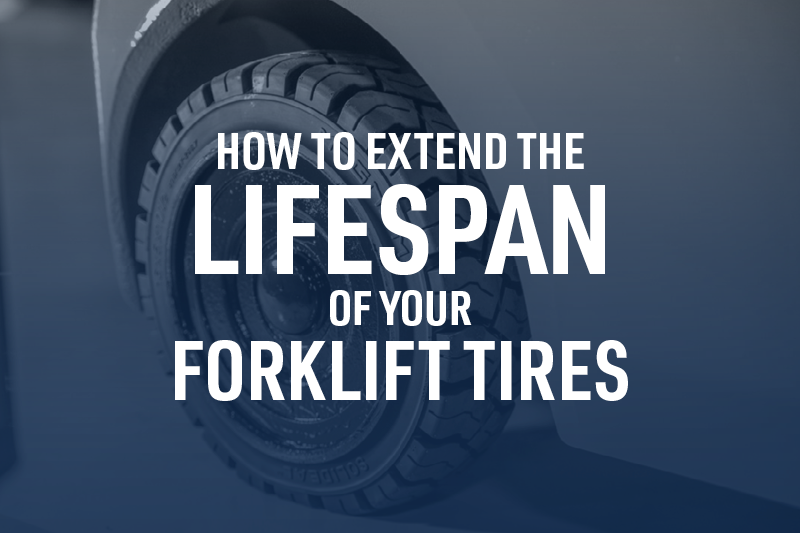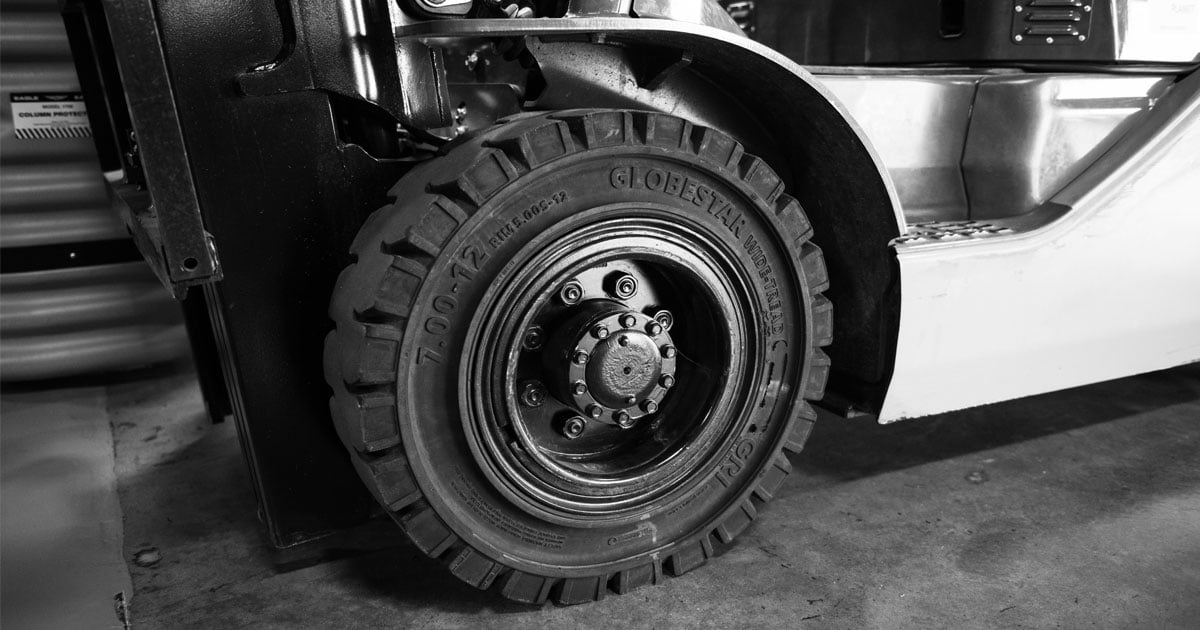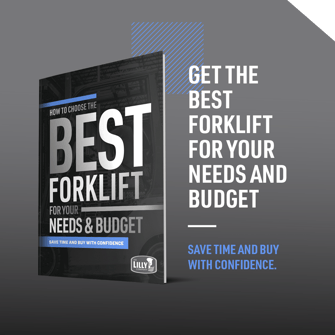
Forklift tires have a significant impact on the performance of your facility. When your tires are well-maintained, you increase productivity, reduce long-term costs, and stay safe. Unless you know how to prevent and spot the signs of damage, new forklift tires will wear out long before you recoup the investment. So, what do you do? This post will tell you how to prolong your forklift tires' service life, spot wear signs early, and lower your replacement costs.
Tips That Make the Most Out of Your Forklift Tires
Taking proper care of your tires can help you recoup and maximize your investment. Here are some recommendations to increase your tire and forklift lifespan.
Know what tires are right for the job. Forklift tire types are not interchangeable since forklifts are typically designed for one type of tire only. You can't replace a pneumatic tire with a cushion tire if your operations evolve. You can switch between different cushion tires for the same forklift. For example, you could choose between treaded or smooth (no treads), or you could select non-marking cushion tires over traditional black ones if you want to prevent those pesky marks on the floor.
To maximize industrial tire life and determine the types of equipment you need, have the nature of your operation in mind. The decision comes down to outdoor use (pneumatic tires), indoor use (cushion tires), or a combination of both.
Prioritize Operator Education
Poor operating habits put your facility at risk and make tires wear faster. Take the time to ensure your team is properly trained—forklift Certification and safety programs come in handy here. Safety training is one of the best ways to protect your team members and prevent expensive incidents (OSHA's minimum fine is around $10,000). Consider refreshing the training regularly to keep your operators' skills sharp and up to date.
Have Regular Tire Inspections
Noticing the early signs of damage can prevent replacement costs. Check your forklift tires at least once a week. Ideally, you should inspect them daily and look for metal chips, glass, or nails. Inspect for chunking, tearing, and cracking to avoid accidents and repair expenses. If discovered, correct before further use.
How do you find time for a thorough inspection of the forklift and tires? Here is a 5-minute checklist reminder you and your team can use before hopping onto the forklift:
- Check all forklift tires for the signs of damage
- For traditional pneumatic tires that actually contain air, check the air pressure
- Make sure wheels are in the right position
- Make sure brakes and controls are functioning properly
Check Air Pressure on Pneumatic Tires
Over-inflated tires can cause a blowout and result in downtime. Under-inflated tires cause poor traction and result in accidents. Find a minute to check the air pressure on your pneumatic tires before each use.
Lubricate Forklift Regularly
Proper lubrication, particularly of the power and braking systems, will reduce tire drag and sudden stops. Avoid over lubrication since excess grease and oil is harmful to your rubber tires.
Keep Brakes in Adjustment
On a forklift, the wheel is a part of the braking system. An improper adjustment of the brakes allows the heat to build up under the baseband. Eventually, you may have a tire blow out or notice a base separation.
Prevent Overloading
Don't take chances with a forklift that may be too small for the job. Overloading is a common cause of chipping, tire blow out, and base separation. Center the load on the forklift so the load on each tire is equal. Keep in mind that fast cornering can move the load away from the center.
Avoid Standing Loads
If you leave loads standing on forklifts overnight or longer, solid tires can form "flat spots." These spots may cause forklift tires to bump. Remember, forklifts are heavy enough already, so letting one sit in one spot too long can be hard on the tires. If bad enough, flat areas will cause a very bumpy ride for the operator and the load, which can lead to unnecessary product damage.
Maintain Aisles in Good Repair
Cluttered floors increase tire damage. Take time to inspect and keep floors free from breaks, cracks, and in good repair. Sharp objects at your facility cut thread and damage forklift tires. Debris such as strapping material, broken pallets, and other objects can truly take their toll on tires.
Avoid Overheating
If a forklift contacts with hot metal or stays in a hot room, such an environment breaks the tire structure down. Eliminate, wherever possible, harmful hot conditions. Shields that prevent heat from striking tires will often prolong tire life.
Limit Oil and Grease
Avoid running tires over oil or grease since they cause damage to rubber compounds. Also, because most traditional indoor forklifts have smooth treads, the addition of grease or oil between the tire and the floor will create a very slippery and dangerous situation. If the tires come in contact with any of these materials, wipe them off immediately. If you can't avoid constant contact with oil or grease, consider oil resistant compounds.

When to Replace Forklift Tires
Why is it essential to replace forklift tires in time? First, you may encounter reduced fuel efficiency. Worn out tires add to the forklift operator's workload, so they get more fatigue and less focused. Finally, you can damage the forklift itself if you postpone tire replacement. Several signs of forklift tire damage will alert you to replace your tires in time.
Tires Have Worn to the Wear Line
Most forklift tire manufacturers provide a wear indicator line. This line represents around 20% of the original tire size. After this point, operating a forklift will add more stress to its components, lower the fuel economy, and increase safety risks. If the rubber has worn down to the line, or the tire wear has reached the top of the lettering on the sidewall, the tire needs replacement.
A Substantial Amount of Tread is Lost
Like you check your car tires, assess the tread height on the forklift tire to determine if it needs replacing. If the tire is balding, it's time for a replacement.
Visible Chunking
If you repeatedly run a forklift over debris, large pieces of rubber will fall off the tire. Chunking can cause a bumpy ride for the operator, increase their fatigue, and damage the load. You can often repair chunking without having to replace the tire completely. Be proactive with your maintenance since this type of damage could lead to a major blowout.
Flat Spots
You may notice flat spots on your tires if the forklift makes sharp turns while carrying a heavy load. If you have more than one flat spot on your tires, you may operate an uneven floor. Flat areas can also show that your forklift is out of alignment. Check your equipment for shaking the next time it drives.
Cracked Tires
If you overload your forklift, the heat within the tire will build up and cause radial cracking. If cracking occurs consistently, consider using a larger or wider tire. It will help to spread the weight of the load. Traveling long distances with no load can also cause the heat to buildup. Instead of being evenly distributed, the counterweight rests on the steer tires.
Routine inspection of your forklift tires is vital. Your operators should check for wear and damage before every operation. If they catch issues early on, they will be safe, and your bottom line won't be affected.
Tire Replacement Based on the Tire Type
Wear and damage signs may differ based on what type of forklift tires you operate on - cushion or pneumatic. Let's look at cushion tires.
- Check for damage where the wheel and the tire meet. When the rubber has separated from the metal band, bond failures happen. If you can fit a screwdriver into the separated area, consider replacing the tire.
- Visually inspect the tread. There is no specific tool to help determine tread wear. Do a visual check. When 25-30% of the available tread has worn, it's time for a replacement.
- Another popular way to check if you need to replace cushion tires is the two-inch rule. See if the tire has lost at least two inches from its original height. You can find the tire's original height on the sidewall of the tire.
How do you spot damage on solid pneumatic tires? A rule of thumb is to go by the amount of wear. It would be best to replace solid pneumatic forklift tires when they have lost 75-80% of the available tread. Though this rule works for most cases, you'll want to take your operators and your application into consideration.
How to Reduce Cost When Replacing Forklift Tires
While it's an investment, newly replaced tires benefit the forklift operator and your facility. You're looking at benefits like maximized efficiency, increased traction, and reduced fuel consumption. New tires also minimize shock. They create a smoother ride for the operator so they can be less tired and more focused. A replacement can even lower maintenance costs. New tires can cover the same distance in fewer rotations causing less wear.
Though it's a necessary expense, there are a few ways you can reduce the cost of replacing your forklift tires.
- If the nature of your operation allows, choose smooth cushion tires over traction tires. In this way, you can increase the consumable rubber percentage. As long as there's no liquid, you'll experience increased traction.
- Upsizing your tires can have several benefits. You may expect better traction, stability, shock absorption, and longer tire life. Your running tires will also remain at colder temperatures. Since the weight spreads along the tire, you can increase the load-carrying capacity.
- Invest in high rubber resilience tires to reduce fuel consumption in gas forklifts and get more running hours out of your electric forklifts.
- Unless you operate in winter conditions, consider replacing your pneumatic tires with solid pneumatic tires. You can extend the tire life, reduce downtime, and increase stability. To ensure your operations will benefit from the switch, consult with your tire dealer.
Let Our Experts Take the Hassle Out of Servicing Your Forklift Tires
Now you know how to extend your forklift tires' life. Make sure you follow proper maintenance steps to maximize its performance. An experienced partner can help.
We're an authorized dealer for Toyota, Clark, Linde, and Komatsu forklifts and serve customers throughout Alabama, Mississippi, Tennessee, and Eastern Arkansas.
Please contact us online or by phone 844-LILLYCO (1-844-545-5926) with any questions you have about cushion or pneumatic forklift tires, maintenance, and replacement. Or say hello at one of our 13 locations:
Arkansas - Jonesboro
Alabama - Birmingham, Dothan, Irondale, Madison, Mobile, and Montgomery
Mississippi - Tupelo and Richland
Tennessee - Jackson, Kingsport, Knoxville, and Memphis
Posts by Tag
- Forklift (61)
- Forklift Service (19)
- Electric Forklifts (16)
- Forklift Safety (14)
- Forklift Attachments (12)
- Toyota Forklifts (12)
- Warehouse Planning (10)
- Parts (9)
- Pallet Racking (8)
- Warehouse Automation (8)
- Clark Forklifts (7)
- Loading Docks (7)
- Material Handling Education (7)
- Customer Solutions (6)
- Forklift Batteries (6)
- Forklift Rental (6)
- Purchasing Options (6)
- Aerial Equipment (5)
- Heavy Equipment (5)
- Forklift Accessories (4)
- Forklift Fleet Management (4)
- Forklift Tires (4)
- Forklift Training (4)
- Products (4)
- Utility Vehicles (4)
- Yard Spotter Trucks (4)
- Linde (3)
- Pallet Jacks (3)
- Specialty Forklifts (3)
- Used Equipment (3)
- Warehouse Doors (3)
- IC Forklifts (2)
- Manitou (2)
- COMBiLift (1)
- Custom Shop (1)
- Forklift Brakes (1)
- Forklift Warranty (1)
- Gehl (1)
- Komatsu (1)
- Product Review (1)
- Recruitment (1)











